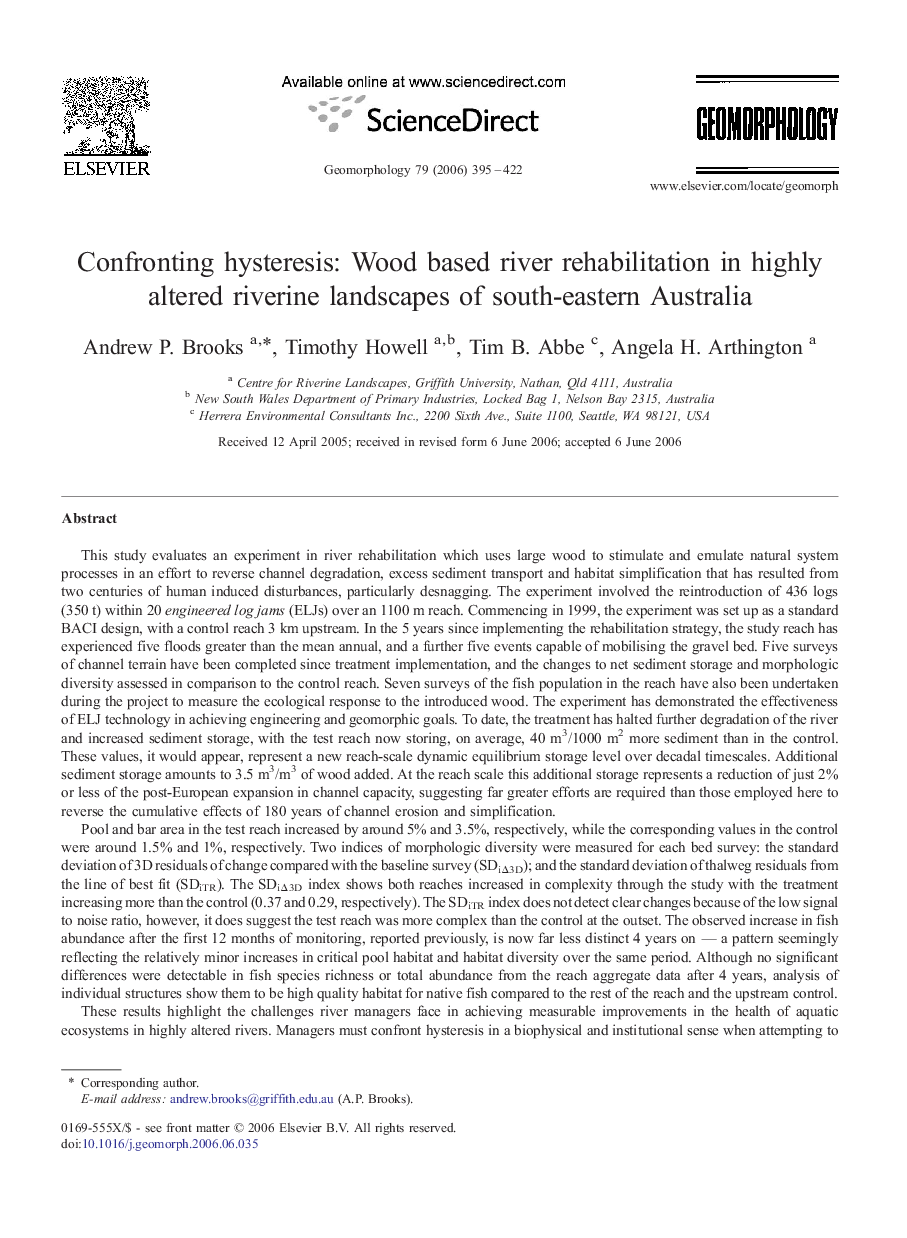| کد مقاله | کد نشریه | سال انتشار | مقاله انگلیسی | نسخه تمام متن |
|---|---|---|---|---|
| 4687493 | 1635593 | 2006 | 28 صفحه PDF | دانلود رایگان |

This study evaluates an experiment in river rehabilitation which uses large wood to stimulate and emulate natural system processes in an effort to reverse channel degradation, excess sediment transport and habitat simplification that has resulted from two centuries of human induced disturbances, particularly desnagging. The experiment involved the reintroduction of 436 logs (350 t) within 20 engineered log jams (ELJs) over an 1100 m reach. Commencing in 1999, the experiment was set up as a standard BACI design, with a control reach 3 km upstream. In the 5 years since implementing the rehabilitation strategy, the study reach has experienced five floods greater than the mean annual, and a further five events capable of mobilising the gravel bed. Five surveys of channel terrain have been completed since treatment implementation, and the changes to net sediment storage and morphologic diversity assessed in comparison to the control reach. Seven surveys of the fish population in the reach have also been undertaken during the project to measure the ecological response to the introduced wood. The experiment has demonstrated the effectiveness of ELJ technology in achieving engineering and geomorphic goals. To date, the treatment has halted further degradation of the river and increased sediment storage, with the test reach now storing, on average, 40 m3/1000 m2 more sediment than in the control. These values, it would appear, represent a new reach-scale dynamic equilibrium storage level over decadal timescales. Additional sediment storage amounts to 3.5 m3/m3 of wood added. At the reach scale this additional storage represents a reduction of just 2% or less of the post-European expansion in channel capacity, suggesting far greater efforts are required than those employed here to reverse the cumulative effects of 180 years of channel erosion and simplification.Pool and bar area in the test reach increased by around 5% and 3.5%, respectively, while the corresponding values in the control were around 1.5% and 1%, respectively. Two indices of morphologic diversity were measured for each bed survey: the standard deviation of 3D residuals of change compared with the baseline survey (SDiΔ3D); and the standard deviation of thalweg residuals from the line of best fit (SDiTR). The SDiΔ3D index shows both reaches increased in complexity through the study with the treatment increasing more than the control (0.37 and 0.29, respectively). The SDiTR index does not detect clear changes because of the low signal to noise ratio, however, it does suggest the test reach was more complex than the control at the outset. The observed increase in fish abundance after the first 12 months of monitoring, reported previously, is now far less distinct 4 years on — a pattern seemingly reflecting the relatively minor increases in critical pool habitat and habitat diversity over the same period. Although no significant differences were detectable in fish species richness or total abundance from the reach aggregate data after 4 years, analysis of individual structures show them to be high quality habitat for native fish compared to the rest of the reach and the upstream control.These results highlight the challenges river managers face in achieving measurable improvements in the health of aquatic ecosystems in highly altered rivers. Managers must confront hysteresis in a biophysical and institutional sense when attempting to reverse the degradation of rivers. The scale of treatment implemented in this experiment was at the upper end of the spectrum of rehabilitation efforts currently being undertaken in Australia, suggesting that far greater resources and longer timescales are required to achieve the levels of improvement in the diversity of stream habitat expected by the community. The study also highlights problems with the strategy of attempting to meet multiple objectives within a reach scale rehabilitation project. While this treatment successfully met some geomorphic study objectives, maximising the benefits for fish habitat would require a strategy focused primarily on the creation of complex woody habitat within deeper pools, particularly pools immediately below riffles.
Journal: Geomorphology - Volume 79, Issues 3–4, 30 September 2006, Pages 395–422